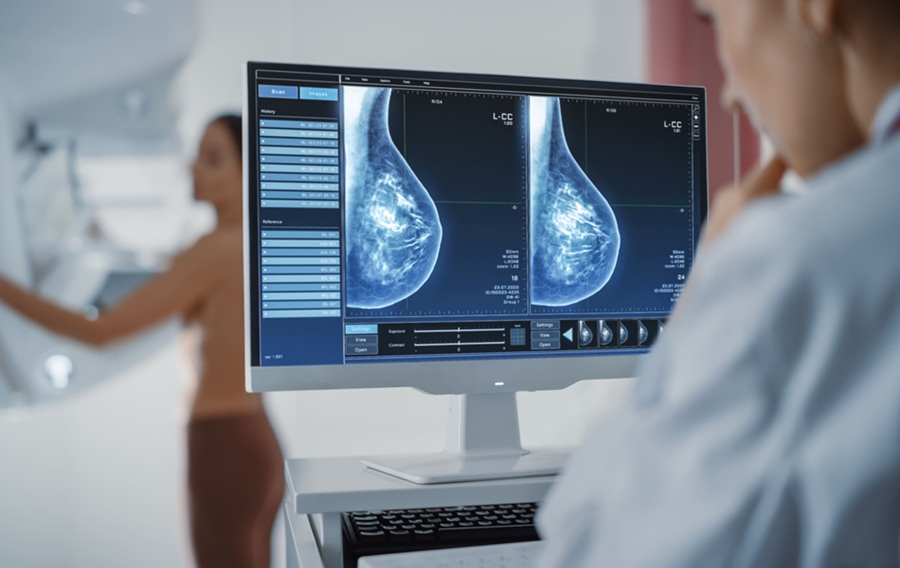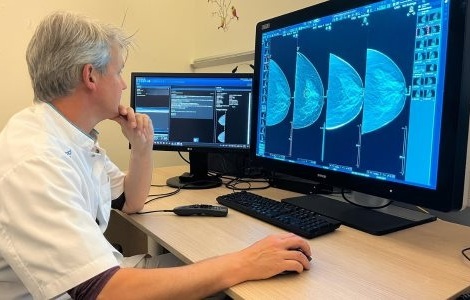AI Predicts Spinal Fractures in Cancer Patients Using CT/MRI Scans
|
By MedImaging International staff writers Posted on 06 May 2022 |

One of the biggest clinical concerns that cancer patients face is the risk of spinal fractures due to spinal metastasis - when disease spreads from other places in the body to the spine - which can lead to severe pain and spinal instability. As medicine continues to embrace machine learning, a new study suggests how scientists may use artificial intelligence (AI) to predict how cancer may affect the probability of fractures along the spinal column.
While many of the changes the body undergoes when exposed to cancerous lesions are still a mystery, with the power of computational modeling, scientists can get a better idea of what’s happening to the spine. The study by researchers at The Ohio State University (Columbus, OH, USA) demonstrated how the researchers trained an AI-assisted framework called ReconGAN to create a digital twin, or a virtual reconstruction of a patient’s vertebra. Unlike 3D printing, where a virtual model is turned into a physical object, the concept of a digital twin involves building a computer simulation of its real-life counterpart without creating it physically. Such a simulation can be used to predict an object or system’s future performance - in this case, how much stress the vertebra can take before cracking under pressure.
By training ReconGAN on MRI and micro-CT images obtained by taking slice-by-slice pictures of vertebrae acquired from a cadaver, researchers were able to generate realistic micro-structural models of the spine. Using their simulation, the team was also able to virtually enlarge the model, a capability the study says is imperative to understanding and incorporating changes into the entirety of a vertebra’s geometric shape. In this case, the researchers used CT/MRI scans from a 51-year-old female lung cancer patient whose cancer had metastasized to simulate what might happen if cancer weakened some of the vertebrae and how that would affect how much stress the bones could take before fracturing.
The model predicted how much strength parts of the vertebra would lose as a result of the tumors, as well as other changes that could be expected as the cancer progressed. Some of their predictions were confirmed by clinical observations in cancer patients. For a field like orthopedics, using a non-invasive tool like the digital twin can help surgeons understand new therapies, simulate different surgical scenarios and envision how the bone will change over time, either due to bone weakness or to the effects of radiation. The digital twin can also be modified to patient-specific needs, according to the researchers. But this was just a feasibility study and much more work is needed, say the researchers. ReconGAN was trained on data from only one cadaveric sample, and more data is needed for AI to be perfected.
“Spinal fracture increases the risk of patient death by about 15%,” said Soheil Soghrati, co-author of the study and associate professor of mechanical and aerospace engineering at The Ohio State University. “By predicting the outcome of these fractures, our research offers medical experts the opportunity to design better treatment strategies, and help patients make better-informed decisions. What really makes the work in a distinct way is how detailed we were able to model the geometry of the vertebra. We can virtually evolve the same bone from one stage to another.”
“The ultimate goal is to develop a digital twin of everything a surgeon may operate on,” added Soghrati. “Right now, they’re only used for very, very challenging surgeries, but we want to help run those simulations and tune those parameters even more.”
Related Links:
The Ohio State University
Latest General/Advanced Imaging News
- New Ultrasmall, Light-Sensitive Nanoparticles Could Serve as Contrast Agents
- AI Algorithm Accurately Predicts Pancreatic Cancer Metastasis Using Routine CT Images
- Cutting-Edge Angio-CT Solution Offers New Therapeutic Possibilities
- Extending CT Imaging Detects Hidden Blood Clots in Stroke Patients
- Groundbreaking AI Model Accurately Segments Liver Tumors from CT Scans
- New CT-Based Indicator Helps Predict Life-Threatening Postpartum Bleeding Cases
- CT Colonography Beats Stool DNA Testing for Colon Cancer Screening
- First-Of-Its-Kind Wearable Device Offers Revolutionary Alternative to CT Scans
- AI-Based CT Scan Analysis Predicts Early-Stage Kidney Damage Due to Cancer Treatments
- CT-Based Deep Learning-Driven Tool to Enhance Liver Cancer Diagnosis
- AI-Powered Imaging System Improves Lung Cancer Diagnosis
- AI Model Significantly Enhances Low-Dose CT Capabilities
- Ultra-Low Dose CT Aids Pneumonia Diagnosis in Immunocompromised Patients
- AI Reduces CT Lung Cancer Screening Workload by Almost 80%
- Cutting-Edge Technology Combines Light and Sound for Real-Time Stroke Monitoring
- AI System Detects Subtle Changes in Series of Medical Images Over Time
Channels
Radiography
view channel
AI Algorithm Uses Mammograms to Accurately Predict Cardiovascular Risk in Women
Cardiovascular disease remains the leading cause of death in women worldwide, responsible for about nine million deaths annually. Despite this burden, symptoms and risk factors are often under-recognized... Read more
AI Hybrid Strategy Improves Mammogram Interpretation
Breast cancer screening programs rely heavily on radiologists interpreting mammograms, a process that is time-intensive and subject to errors. While artificial intelligence (AI) models have shown strong... Read moreMRI
view channel
AI-Assisted Model Enhances MRI Heart Scans
A cardiac MRI can reveal critical information about the heart’s function and any abnormalities, but traditional scans take 30 to 90 minutes and often suffer from poor image quality due to patient movement.... Read more
AI Model Outperforms Doctors at Identifying Patients Most At-Risk of Cardiac Arrest
Hypertrophic cardiomyopathy is one of the most common inherited heart conditions and a leading cause of sudden cardiac death in young individuals and athletes. While many patients live normal lives, some... Read moreUltrasound
view channel
Non-Invasive Ultrasound-Based Tool Accurately Detects Infant Meningitis
Meningitis, an inflammation of the membranes surrounding the brain and spinal cord, can be fatal in infants if not diagnosed and treated early. Even when treated, it may leave lasting damage, such as cognitive... Read more
Breakthrough Deep Learning Model Enhances Handheld 3D Medical Imaging
Ultrasound imaging is a vital diagnostic technique used to visualize internal organs and tissues in real time and to guide procedures such as biopsies and injections. When paired with photoacoustic imaging... Read moreNuclear Medicine
view channel
PET Tracer Enables Same-Day Imaging of Triple-Negative Breast and Urothelial Cancers
Triple-negative breast cancer (TNBC) and urothelial bladder carcinoma (UBC) are aggressive cancers often diagnosed at advanced stages, leaving limited time for effective treatment decisions.... Read more
New Camera Sees Inside Human Body for Enhanced Scanning and Diagnosis
Nuclear medicine scans like single-photon emission computed tomography (SPECT) allow doctors to observe heart function, track blood flow, and detect hidden diseases. However, current detectors are either... Read more
Novel Bacteria-Specific PET Imaging Approach Detects Hard-To-Diagnose Lung Infections
Mycobacteroides abscessus is a rapidly growing mycobacteria that primarily affects immunocompromised patients and those with underlying lung diseases, such as cystic fibrosis or chronic obstructive pulmonary... Read moreImaging IT
view channel
New Google Cloud Medical Imaging Suite Makes Imaging Healthcare Data More Accessible
Medical imaging is a critical tool used to diagnose patients, and there are billions of medical images scanned globally each year. Imaging data accounts for about 90% of all healthcare data1 and, until... Read more
Global AI in Medical Diagnostics Market to Be Driven by Demand for Image Recognition in Radiology
The global artificial intelligence (AI) in medical diagnostics market is expanding with early disease detection being one of its key applications and image recognition becoming a compelling consumer proposition... Read moreIndustry News
view channel
GE HealthCare and NVIDIA Collaboration to Reimagine Diagnostic Imaging
GE HealthCare (Chicago, IL, USA) has entered into a collaboration with NVIDIA (Santa Clara, CA, USA), expanding the existing relationship between the two companies to focus on pioneering innovation in... Read more
Patient-Specific 3D-Printed Phantoms Transform CT Imaging
New research has highlighted how anatomically precise, patient-specific 3D-printed phantoms are proving to be scalable, cost-effective, and efficient tools in the development of new CT scan algorithms... Read more
Siemens and Sectra Collaborate on Enhancing Radiology Workflows
Siemens Healthineers (Forchheim, Germany) and Sectra (Linköping, Sweden) have entered into a collaboration aimed at enhancing radiologists' diagnostic capabilities and, in turn, improving patient care... Read more




 Guided Devices.jpg)















